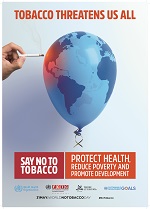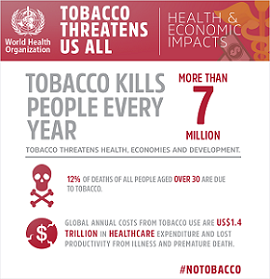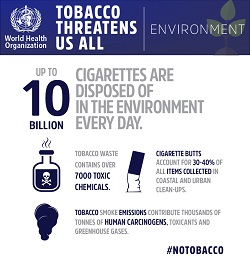 Every year, on 31 May, the World Health Organization (WHO) and partners mark World No Tobacco Day (WNTD), highlighting the health and additional risks associated with tobacco use, and advocating for effective policies to reduce tobacco consumption.
Every year, on 31 May, the World Health Organization (WHO) and partners mark World No Tobacco Day (WNTD), highlighting the health and additional risks associated with tobacco use, and advocating for effective policies to reduce tobacco consumption.
On World No Tobacco Day 2017, WHO was highlighting how tobacco threatens the development of nations worldwide, and was calling on governments to implement strong tobacco control measures. These include banning marketing and advertising of tobacco, promoting plain packaging of tobacco products, raising excise taxes, and making indoor public places and workplaces smoke-free.
Action to stamp out tobacco use can help countries prevent millions of people falling ill and dying from tobacco-related disease, combat poverty and, according to a first-ever WHO report, reduce large-scale environmental degradation.
Tobacco’s health and economic costs
 Tobacco use kills more than 7 million people every year and costs households and governments over US$ 1.4 trillion through healthcare expenditure and lost productivity.
Tobacco use kills more than 7 million people every year and costs households and governments over US$ 1.4 trillion through healthcare expenditure and lost productivity.
„Tobacco threatens us all,“ says WHO Director-General Dr Margaret Chan. „Tobacco exacerbates poverty, reduces economic productivity, contributes to poor household food choices, and pollutes indoor air.“
Dr Chan adds: „But by taking robust tobacco control measures, governments can safeguard their countries‘ futures by protecting tobacco users and non-users from these deadly products, generating revenues to fund health and other social services, and saving their environments from the ravages tobacco causes.“
All countries have committed to the 2030 Agenda for Sustainable Development, which aims to strengthen universal peace and eradicate poverty. Key elements of this agenda include implementing the WHO Framework Convention on Tobacco Control, and by 2030 reducing by one third premature death from noncommunicable diseases (NCDs), including heart and lung diseases, cancer, and diabetes, for which tobacco use is a key risk factor.
Tobacco threatens women, children, and livelihoods
Tobacco threatens all people, and national and regional development, in many ways, including:
- Poverty: Around 860 million adult smokers live in low- and middle-income countries. Many studies have shown that in the poorest households, spending on tobacco products often represents more than 10% of total household expenditure – meaning less money for food, education and healthcare.
- Children and education: Tobacco farming stops children attending school. 10% – 14% of children from tobacco-growing families miss class because of working in tobacco fields.
- Women: 60% – 70% of tobacco farm workers are women, putting them in close contact with often hazardous chemicals.
- Health: Tobacco contributes to 16% of all noncommunicable diseases (NCDs) deaths.
Tobacco scars the environment
 The first-ever WHO report, Tobacco and its environmental impact: an overview, also shows the impact of this product on nature, including:
The first-ever WHO report, Tobacco and its environmental impact: an overview, also shows the impact of this product on nature, including:
- Tobacco waste contains over 7000 toxic chemicals that poison the environment, including human carcinogens.
- Tobacco smoke emissions contribute thousands of tons of human carcinogens, toxicants, and greenhouse gases to the environment. And tobacco waste is the largest type of litter by count globally.
- Up to 10 billion of the 15 billion cigarettes sold daily are disposed in the environment.
- Cigarette butts account for 30% – 40% of all items collected in coastal and urban clean-ups.
Find more information on World No Tobacco Day here.
For more infographics click here.
Published in GI-Mail 06/2017 (English edition). Sign up for GI-Mail here. 
Tip: More up to date educational events can be found online in the Education Database »medicine & health«.
